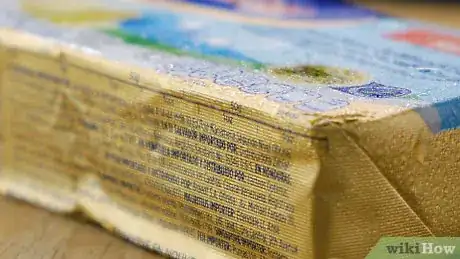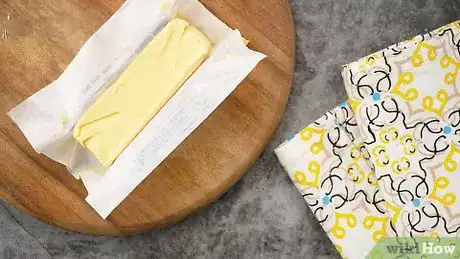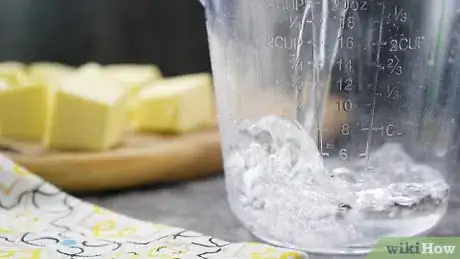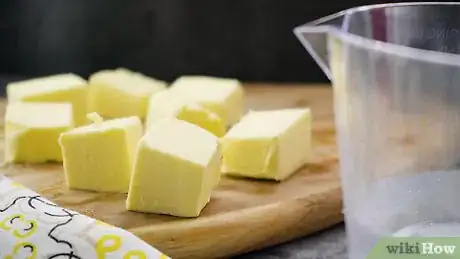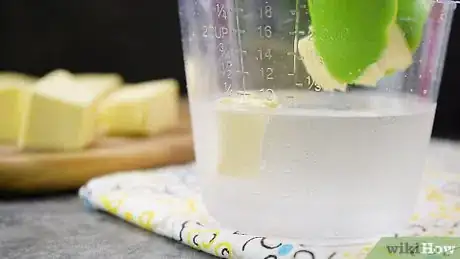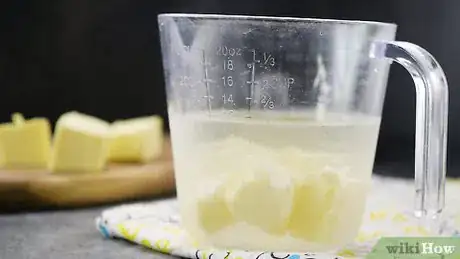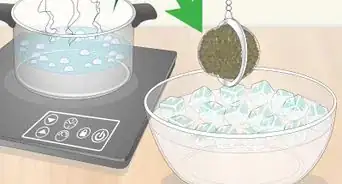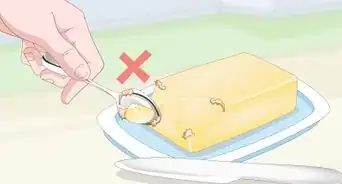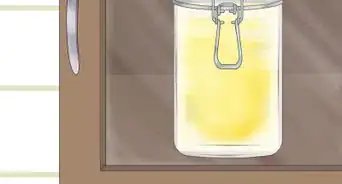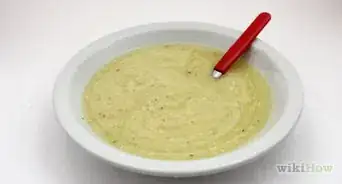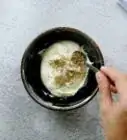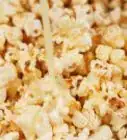This article was co-authored by wikiHow Staff. Our trained team of editors and researchers validate articles for accuracy and comprehensiveness. wikiHow's Content Management Team carefully monitors the work from our editorial staff to ensure that each article is backed by trusted research and meets our high quality standards.
The wikiHow Video Team also followed the article's instructions and verified that they work.
This article has been viewed 107,783 times.
Learn more...
Whether you’re baking a cake or making a family dinner, many recipes call for butter. But there are all kinds of measurements for using butter—sticks, pounds, tablespoons, cups. This can get confusing. With a few easy steps, however, you can make sure you measure the correct amount of butter every time. Once you've checked your recipe and found out the amount of butter you need, you can start measuring it out.
Steps
Measuring Butter by the Stick
-
1Check the butter wrapper for measurements. Butter sticks often have measurements printed on the wrapper. These help measure out butter for recipes.[1] Search all sides of the wrapper to see if there are lines. If the wrapper has markings, each section represents one tablespoon of butter.
- Standard sticks of butter have 8 tablespoons (120 ml) total, but double check to confirm the tablespoons in your stick.
-
2Cut the amount of butter you need. If your butter wrapper has measurements, then you can easily tell the amount you'll have to cut.[2] Place the butter on a flat cutting board or plate.If your recipe calls for 3 tablespoons (44.4 ml) of butter, find the line that reads “3.” Use a knife and cut on that line.
- Remember a sharp knife is better here. A dull knife will crush the butter instead of cleanly cutting through it.
- It’s okay to cut directly through the wrapper. Just remember to peel it off before cooking!
Advertisement -
3Mark the halfway point in the stick of butter. If your butter wrapper didn't have markings or you got rid of the wrapper, you can still mark up the butter stick for accurate measurements. Take a ruler and measure the stick of butter. Then gently press a knife into the butter to mark the halfway point.
-
4Cut the butter into tablespoon sections. After you've marked the halfway point of your butter stick, dividing it into tablespoon sections is easy.[3] First cut the stick in half along the line you marked. Then cut each half in half. Finally, cut each quarter section in half again. You now have 8 sections of butter. Each section is 1 tablespoon.
Scooping Butter into a Measuring Cup
-
1Count the amount of sticks you have. Each standard stick of butter is ½ cup. If your butter comes in sticks, you can convert that measurement into the amount of cups you need without any measuring.[4]
- For example, if your recipe calls for 2 cups, you need 4 sticks.
-
2Scoop the butter into a dry measuring cup. If your butter doesn’t come in sticks or the sticks are irregular, you can easily still measure cups by using a measuring cup and a spoon.[5] Begin by scooping the butter into the measuring cup.
- Keep an eye on the fill lines as you scoop to make sure you're adding the right amount of butter.
- Remember that this method works best for soft butter. If your butter is hard, Method 3 will work better.
-
3Push down on the butter with a rubber spoon. As you're scooping, you have to make sure there aren't any empty spaces left in the butter or your measurement will be off.[6] Every few scoops, take the spoon and push down lightly on the butter in the cup.
- This practice will expel any air from the measuring cup and help you get an accurate measurement.
-
4Level off the top. After you’ve scooped the right amount of butter into the measuring cup, use a knife or spatula to level off the top. This will make sure you don’t use too much butter in your recipe.[7]
-
5Scoop the butter out as needed. Now that you have an accurate butter measurement, you’re ready to add it to your recipe.
Using Water to Measure Butter
-
1Slice your butter into cubes. If your butter is hard, irregularly shaped, or difficult to measure, the displacement method is perfect for you.[8] Place your butter on a flat cutting board or plate. Using a sharp knife, carefully slice your butter into dice-sized cubes.
- Remember, it's important to make sure your knife is sharp. If your knife is dull, you'll just crush the butter instead of slicing cleanly.
-
2Fill a measuring cup up to the 1 cup line with cold water. For this method, you'll need a measuring cup that holds at least 2 cups, so it will only be half full when you fill it.
- Remember to bring the measuring cup lines up to your eye level so you can clearly see how much water you have.
- Use cold water for this method. Warm water could melt your butter.[9]
-
3Calculate the amount of butter cups you need. This method works by measuring the amount of water the butter displaces in the measuring cup. Use this simple method to calculate the amount you'll need.[10] Since you have 1 cup of water in the measuring cup, add the amount of butter cups you need to 1. This will show you the total volume in the measuring cup.
- For example, if you need ¼ cup of butter, then the measuring cup should have 1 and ¼ cups total when you’re finished.
-
4Put the butter pieces in the measuring cup. The water will begin rising as the butter pieces displace water.[11]
- Work slowly to avoid overflowing the cup. Don't dump all the butter in at once.
-
5Push the butter down if it starts piling up. You’ll want to stop the butter from building up in one area. If it breaks the surface of the water, your measurement will be off.[12]
- Use a knife or fork to push the butter down if needed.
- The butter doesn’t have to be evenly distributed for this method to work, but don't let the butter break the water’s surface.
-
6Stop adding butter when the water reaches the point you need. Keep monitoring the water as it rises, and make sure you stop if the cup looks like it will overflow.
- If you need ¼ cup of butter, stop when the water reaches the 1 and ¼ mark.
-
7Drain the water. Start by placing a strainer over the sink. Pour the water into the strainer. Finish by removing any butter that fell into the strainer and putting it back in the measuring cup.
Things You'll Need
- butter
- knife
- cutting board
- measuring cup
- strainer
References
- ↑ https://www.bettycrocker.com/how-to/tipslibrary/ingredients/measuring-ingredients
- ↑ https://www.bettycrocker.com/how-to/tipslibrary/ingredients/measuring-ingredients
- ↑ https://challengedairy.com/tips-and-techniques/measuring-butter
- ↑ https://www.landolakes.com/kitchen-reference/measurements-abbreviations/
- ↑ https://www.dairygoodness.ca/butter/butter-tips-tricks/how-to-measure-butter
- ↑ https://www.dairygoodness.ca/butter/butter-tips-tricks/how-to-measure-butter
- ↑ https://www.dairygoodness.ca/butter/butter-tips-tricks/how-to-measure-butter
- ↑ https://www.dairygoodness.ca/butter/butter-tips-tricks/how-to-measure-butter
- ↑ https://www.landolakes.com/kitchen-reference/measurements-abbreviations/
